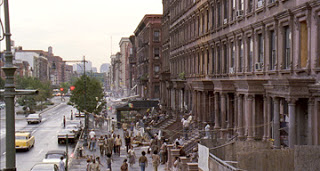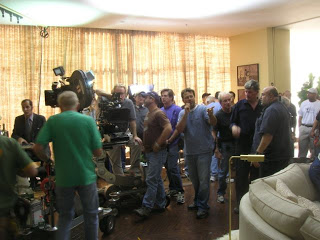“American Gangster” crossed 110th street into a theater near you November 2nd. All sound editorial trafficking was handled by co-supervising sound editors Per Hallberg and Karen M. Baker. Coming off a strong summer with “The Bourne Ultimatum”, “Gangster” marks over the 40th collaboration between the two. Mixing posted up at Todd-AO West in Santa Monica with re-recording mixers Bob Beemer and Mike Minkler. The pair is winding down a busy ’07 with “Mr. Magorium’s Wonder Emporium” and have separately worked on films ranging from “Into the Wild”(Minkler) to the aforementioned “The Bourne Ultimatum” (Beemer). The production sound pusher on “Gangster” was William Sarokin who can currently be seen ogling expensive footwear with the girls from “Sex in the City: The Movie”. Marc Streitenfeld handled the score on “Gangster”. A protégé of Hanz Zimmer, this marks the second film Steitenfield composed for director Ridely Scottsince 2006’s “A Good Year”. Once again, Soundtrack.net has a great little photo essay on the tracking that took place at Sony, HERE. Mix Magazine also has a great piece touching upon the editorial and mixing of the Film, HERE.
I just wanted to thank Production Sound Mixer William Sarokin for taking time for this Q and A.
DS: I read recently that Ridley Scott really shot from the hip on this one: fast moving, quick set ups, etc. How does this type of shoot effect the sound department, especially on a show that is set in such an aural jungle like NYC?
WS: Ridley is a master at capturing every bit of energy there is in a scene. Nothing (well… except for thousands of feet of unused film…) goes to waste. As much as possible he would use multiple cameras in a scene. Often cameras would be hidden in the shot. He’d have set dressing find a piece of furniture or a car (or even a potted plant) to hide a camera and crew. And just in case, he’d often dress the camera operators in period wardrobe. Ridley is always thinking and looking for opportunities, so if he sets up a shot with 3 cameras looking in one direction, just before we’re about to shoot he might set up a 4th (or 5th or more) looking in the opposite direction. Every department had to be on their toes. At first I thought sound was the only dept that was out of the loop. I assumed the Director of Photography had planned all the alternative shots in advance with his gaffer and key grip, but eventually I realized we were all in the same boat.
One example: In the script there was an 1/8th page scene where Russell Crowe and his fellow officers race up the stairs of a housing project. Ridley turned that into a scene where 2 teams of cops barge into the lobby of a building, subdue tenants and drug dealers in the lobby, race up 2 sets stairs for 6 flights (speaking quietly into walkies at key points) and then plan how to take out 2 guards at the drug dealers door. There was dialog throughout, from the lobby, up the stairs, down the hall and at the drug dealer’s door. If I remember correctly, 5 cameras were hidden en-route. I had to figure out how to record everything for every camera. Oh, and by the way, did I mention the entire sequence was shot simultaneously?
Every crew member, from sound and camera to props, wardrobe, lighting and grip, etc., had to be at the top of their game. The result is a dynamic scene with a live performance feel because it is in effect, a live performance. Instead of shooting the same scene numerous times from different camera perspectives, (and in the process draining every bit of life out of it) Ridley shoots his scenes in relatively few setups and few takes.
In one of the rare quiet moments on set he told me he got his start doing live television. Then it all made sense.
NOTE: the below photo of a typical shot. That’s Ridley on the camera facing up. Both cameras, facing in opposite directions were both working for this shot.
DS: In my limited experience shooting production sound, overcoming obstacles on set that hinder a good sounding scene are the most rewarding experiences on a gig. What are some of the biggest hurdles you leapt over?
WS: Radio Range. How do you cover 2 camera crews 3 blocks apart shooting the same scene simultaneously? Or how do you cover an entire apartment building from lobby to the 6th floor and from one end to the other? It was a given that the majority of the film was recorded on wireless body mics, but even my boom mics are wireless. Fortunately I had help, I’m using the newest generation of Zaxcom radio mics that include built in recorders, so even
when I did lose range, I could take the SD cards out of the transmitters after the scene and re-record them. To my great benefit, Ridley had a world class post production team who would edit the re-recordings into the dailies track to make me look like an absolute genius at the daily screenings.
Hmmmm… creaky floors. Everyone thinks my toughest days are when we are in noisy environments like a factory or near an airport. NOT! It’s when we are in quiet environments and ‘friendly fire’ (noise created by the filming process) rears its ugly head. Nothing like a slow dolly shot across a creaky floor to make me pull my hair out! Specifically to ‘Gangster’, my main obstacles were:
1) Finding a place to hide me and my sound cart and yet stay in radio range of all the action. Considering the number of multi-camera shots covering huge areas, this was not easy.
2) Once finding a place to hide my next problem is getting the gear there. The narrow, 1/2 mile elephant trail in northern Thailand, all uphill and dotted with elephant droppings comes to mind, especially when the multiple cameras saw North, south, East AND West simultaneously.
3) Once hidden, my next trick is to get microphones near the people who speak (or may speak…often non-scripted characters would break into dialog with Ridley’s eager prodding). While I use many wireless mics on the actors I also love to plant mics when the situation allows it. I have a few Audio Ltd analog FM wireless mics that accept Schoeps microphone heads. I’ll often plant them in car visors or on desks, or behind trees (or elephant pies). They are my favorite ‘secret weapon’
DS: What factors determine the level of sound perspective achievable in a scene? How important is that perspective at all during the shoot?
WS: I think proper perspective is very important. I almost always try to make the recording match the camera shot. Of course, there is always ‘movie magic’ that allows you to hear characters walking a block away having a quiet conversation as if you were right next to them. So, there are times when you surrender that perspective, but mostly, my goal is to:
1) make sure the dialog is audible.
2) while keeping it audible, try to make it sound natural.
I am very tolerant of noises caused by something you see in a shot or would expect to hear in that shot. I’ll often allow background noises to continue (even if the film crew has control) because it can affect the actors’ performance. For instance, in the film “North Country” we had a big scene in the machinery room at a pit mine in New Mexico. The noise was deafening, but I had the characters mic’d in their hardhats and I knew they would be audible. Out first shot was on Charlize Theron and the camera was facing away from the machinery so the assistant director had it turned off. I asked for it to be turned back on because I knew if we filmed the first shot with the machines off the actors would speak fairly quietly while when we turned around and filmed with the machines on they would be screaming. Nothing would have matched, so I asked for the machines to be left on for the entire sequence. The assistant director and location person were not used to a sound person asking for noise makers to be turned on, but the scene worked perfectly (sound-wise) if I do say so myself :-)
I am very intolerant of friendly fire – floor creaks caused by a slow moving dolly and crew, background chatter, walkie talkies, etc., or inappropriate locations (ie, trying to do a bucolic country scene near a major interstate, etc).
DS: We all know that getting in early is important for any film craft. In sound, if you’re lucky you get hired before location scouting commences. How often have you been involved in that process? Why doesn’t this happen more often?
WS: I’m never hired before the location scouting begins. I usually have 4-5 days prep on most films while the location manager starts months before production begins. My prep consists of 2-3 days of tech scouting, a day for the production meeting and a day for the equipment load in so often the best I can do is damage control. Often the UPM will call me weeks in advance if there is a question about a location they want to use but are concerned
about sound issues, but that is pretty rare.
DS: Are you ever in a theater watching a film you worked on and wonder “what happened to my mix?”
WS: The sound systems in many theaters are so bad that usually I’m concerned more with the presentation than the mix! Usually post teams on the films I have worked on do a terrific job, though every now and then something will sneak in that will make me cringe. Often it’s the result of someone in post using the wrong track for a scene and somehow it sneaks through the cracks. There was a short scene in “Inside Man” where I blew the mix. A character ad-libbed a line and I had the other actor’s mic opened and it phased terribly (made the actor sound for a word or 2 like someone was holding his nose). I had recorded the scene multi-track so each mic was soloed (pre-fader) on their own channel, so it was extremely easy to re-mix it in post to correct the mistake, but I guess it slipped on through. Makes me cringe every time!
DS: What was your first gig like?
WS: Oh my gosh, it was for Austrian TV news a million years ago and the journalist was doing a standup in front of a Con Ed power plant on the east side of Manhattan. In my limited German it sounded like he was saying ‘Here I am in front of a nuclear power plant right in the middle of Manhattan’. So I asked the producer if that is what he was saying. He said ‘yes’ and I said it wasn’t a nuclear power plant. They said “…Of course it is.” Vienna told them. And I was never hired by Austrian TV again :-)


[…] https://designingsound.org/2007/11/exclusive-interview-with-william-sarokin-production-sound-mixer-on… […]